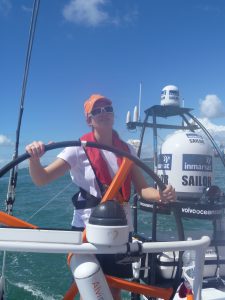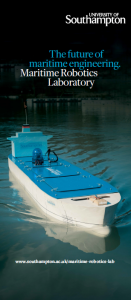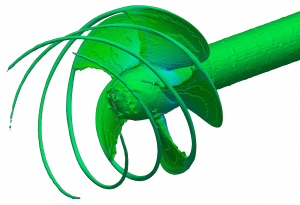 Second year FSI PhD student Laura Marimon Giovannetti reports on her attendance at the High Performance Yacht Design conference held in Auckland during the Volvo Ocean Race stopover.
Second year FSI PhD student Laura Marimon Giovannetti reports on her attendance at the High Performance Yacht Design conference held in Auckland during the Volvo Ocean Race stopover.
The topics of the conference were mainly on sail and wing-sails aerodynamics, foiling and yacht hydrodynamics. Regarding universities researches, the hot topics of the research from the University of Auckland are mainly experimental techniques for downwind sailing aerodynamics and slamming motions. Moreover, a presentation from the Politecnico di Milano was given on sails flying shapes detection. Ecole Navale presented work on strategic decision making in yacht match racing and one on cavitating hydrofoils. The representative from Edinburgh university was not able to come and therefore I was the only representative for the UK HE sector but their main studies are alongside the ones from the University of Auckland on aerodynamics of sails (numerical approaches).
Interesting keynotes were given by Burns Fallow (from North Sails) that explained the development of the AC72 wing and by Paolo Manganelli (ex FSI PhD, now at Gurit) who gave a lecture on the load monitoring system of the VO65.
Not only the conference was extremely interesting, but there was a good mix with the industry visits to Core composites – that builds Oracle – , Southern spars – that builds the rigging of the VO65 – and the University of Auckland) gave me the possibility of understanding the research and development that are performed in the southern hemisphere.
My presentation on passive adaptive composite performance of NACRA foils was followed by very constructive discussions. It also allowed me to mention the University of Southampton’s facilities, from our tests in the R.J. Mitchell wind tunnel as well as the new towing tank!
The Volvo Ocean Race stopover gave me the possibility of interacting with Knut Frostad (the CEO of the Volvo Ocean Race) and to better understand the Team Vestas Wind incident. Finally, given my sailing career, I was fortunate enough to be a guest onboard Team Alvimedica on the practice race, where I have helmed in the final downwind leg!
Monthly Archives: March 2015
Maritime Autonomy update

FSI members presented at the launch of the University Strategic Research Group (USRG) in Autonomous Systems on Friday 20th March. The USRG undertakes work in autonomous systems, sensing, computing, communications and platforms in order to provide world class, cost effective capabilities for scientists and other users. The developed technologies will be employed by society to develop and maintain a low carbon economy, conduct earth science research and other applications from sub-sea, surface, land, air and space.
Presentations were given by Dr Sally Bennett in ‘Autonomous Maritime Platforms – surface and submerged’ discussing the autonomous platforms developed here in Southampton and jointly with the NOC, Dr Gabriel Weymouth in ‘Maritime robotics – getting up close’ discussing the development of persistent energy sources and the potential of soft materials in the future development maritime robotic systems, Ms Cath Holyhead in ‘Autonomous marine sensors for energy scavenging from fixed moorings’ discussing her PhD work, and Dr Jon Downes in ‘Smart Autonomous Ships for safer seas’ discussing the potential uses of autonomy in ships, the potential for autonomous systems for inspection of ship structures, and highlighting the work of the maritime robotics laboratory (www.southampton.ac.uk/maritime-robotics-lab).
Material Tailoring for Lightweight and Morphing Structures- the Shapes of things to come!”
Today’s seminar from Professor Paul Weaver will take place in B27 room 2003 from 14:00-15:00.
Abstract
A structure should resist loads without failing. For structures that contain humans, i.e. houses, boats, cars, aeroplanes etc., they do not stretch (or deform) a great deal (thankfully!) and those that are required to move around should be lightweight to keep fuel costs down e.g. aeroplanes and superlightweight to overcome gravity (e.g. rockets, spacecraft). This seminar explores the possibility of using unusual properties of materials with some additional nonlinear geometric behaviour to either reduce mass or to achieve a significant shape change (morphing) of a structure. Examples are drawn from bicycles, aeroplanes, helicopters, rockets, wind turbine blades, my Ferrari (I wish!) and Nature.
Biography
Paul Weaver is a Chair in Lightweight Structures at the University of Bristol and and until recently was its Engineering Faculty Research Director. He also directs the ACCIS Centre for Doctoral Training. He has published in excess of 200 refereed papers, had 5 patents and graduated 25 PhD students. He has worked on composite structures since 1987, firstly at Newcastle University and what was then Courtauld’s Aerospace on his PhD, before joining Prof Mike Ashby and his group as a postdoc at Cambridge University. Paul then joined Bristol University in 1998, becoming an EPSRC Advanced Research Fellow from 2002-2007 and then gaining his Chair in 2009. During this time Paul was a regular visitor and consultant to NASA Langley on buckling and postbuckling design methods of plate and shell structures. He has worked with Airbus on various projects since 1999 and has delivered methods for coupled stress/temperature modelling for what was then the A3XX, buckling solutions for anisotropic plates, optimisation methods for composite plates, design for stringer plate terminations and most recently on spatially variable stiffness composite plates under the ABBSTRACT project. His anisotropic blade concept for the BERP IV blade is flying on EH101 helicopters. More broadly, his work on morphing composites is being considered for use in wind turbine designs, F1 and high performance boats.
Foiling experts…
A group of FSI members helped CNN’s Mainsail programme presenter Shirley Robertson (double GB Sailing Gold medal winner) present a piece on the physics of foiling craft using Southampton Solent’s towing tank. The episode can be found via the on-line link below. There are three parts with our contribution featured in the second. There are some really nice shots of our new building and Gabe Weymouth and Joe Banks provide convincing commentaries. As with all TV there was a significant amount of background preparation (and hanging around) to get the right shots! Many thanks to all concerned and especially James Blake who helped pull it all together following an initial discussion after Shirley’s inspiring lecture last year as part of our University of Southampton – RNLI joint Technology Partnership programme.
http://edition.cnn.com/videos/tv/2015/03/11/spc-mainsail-design-special-b.cnn/video/playlists/intl-mainsail/
Engines and Data March 12th 14:00-15:00 B175/1025
Professor Richard Stobart, Technical Director Caterpillar Innovation & Research Centre at Loughborough University will deliver an invited seminar on
“Engines and Data: How strategies for data can change the design, development and operation of an established concept”.
Abstract
The heat engine is a very long established concept – and for most of its existence the solutions to efficient and reliable operation lay in the domain of mechanical engineering. Recently, increasing pressure on air quality and fuel efficiency, has led to the introduction of electronic management schemes for engines that replaced complex mechanical components. Electronic schemes were able to offer automation of data collection and enable diagnosis and prognosis, particularly in equipment where an engine failure posed a safety risk or would result in significant financial loss.
Data taken from the fundamental processes of the engine has always been important in understanding and diagnosing development issues and during operation, incipient faults. Sensing methods are allowing even those high speed data streams to be analysed and their features incorporated into schemes that include other observations from the engine. Today’s very substantial flows of data from the engine offer potential to accelerate the development process and to begin to change the nature of engine components and their operation.
This presentation will briefly reflect on the history of the heat engine and the early uses of data, before reviewing the current use of data in control and diagnosis. We will consider new techniques that are emerging from current research and assess their potential impact on not just heat engines but the wider use of capital intensive equipment.
Biography
Richard Stobart is Professor of Powertrain Systems at Loughborough University. Loughborough was the UK’s first technological University and is ranked as world class in Mechanical, Aeronautical and Manufacturing Engineering.
He is responsible for the development of research and education in the field of vehicle engineering, with a particular focus on propulsion and power generation systems.
He was Professor of Automotive Engineering at the University of Sussex (Brighton, UK) from 2001 to 2007 where he was also Head of Engineering and Design from 2003 to 2006.
Professor Stobart was a member of the team who, in 1997 received Arthur D Little’s Ketteringham prize for their work in developing fuel cell technology. The prize was offered annually for the most significant contribution to the company’s products and capabilities. He is a graduate of the University of Cambridge with a first class honours degree in Mechanical Engineering. He was elected a Fellow of the UK Institution of Mechanical Engineers in 2000 and Fellow of the Society of Automotive Engineers in 2015.
Latest OpenFoam Group meeting

We held our semi-regular meeting for people using the open-source Computational Fluid Dynamics (CFD) tool, OpenFOAM (http://www.openfoam.com/). The meeting saw an attendance of over 15 postgraduate students, staff and alumni from research groups across the University, Lloyd’s Register and industry.
Hydrofoil_cavitation_video
We had an opportunity to get to know people dealing with similar problems, expand our knowledge of applicability of OpenFOAM to different engineering problems, and have a refreshing break from chewing through the log files of our simulations. The next meeting is planned at the end of the summer term so keep your eyes open for the announcement around mid-June.
Success at SET for Britain award
 I wish to extend our hearty congratulations to one our of PhD students Agnieszka who was awarded a Bronze medal in the final event of the SET for Britain Engineering category held at the Houses of Parliament. ‘The SET for Britain award exists to “present and discuss “ground-breaking” and frontier UK research and R&D to members of both Houses of Parliament at Westminster”.
I wish to extend our hearty congratulations to one our of PhD students Agnieszka who was awarded a Bronze medal in the final event of the SET for Britain Engineering category held at the Houses of Parliament. ‘The SET for Britain award exists to “present and discuss “ground-breaking” and frontier UK research and R&D to members of both Houses of Parliament at Westminster”.
Dr James Blake her PhD Supervisor commented that Agnieszka’s research centres on the through life degradation mechanisms for natural composites for structural marine applications, supported by LR. Her research transcends the levels of quantum chemistry to structural component level and looks at re-engineering natural resin systems for optimum performance. Agnieszka is co-supervised by Dr Alan Chambers and by Dr Robert Raja with whom we have the good fortune of working closely with in Chemistry through our SMMI links.
engineering@outhampton did well overall picking up the silver and bronze awards in the Engineering category.
